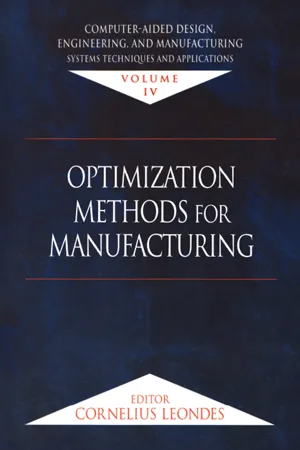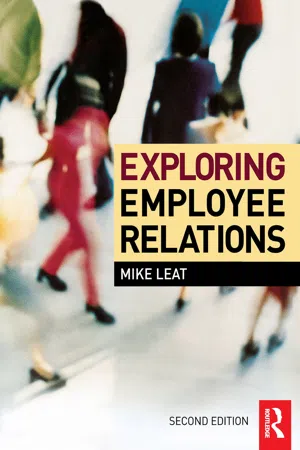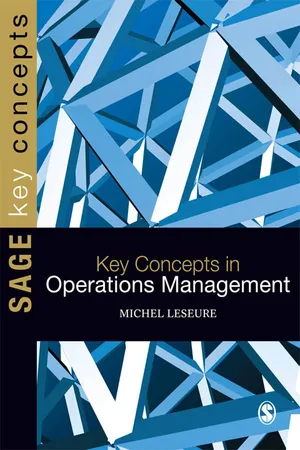Business
Flexible Production
Flexible production refers to the ability of a business to quickly and efficiently adjust its production processes in response to changes in demand, technology, or other factors. This approach allows companies to adapt to market fluctuations, customize products, and minimize waste. By implementing flexible production methods, businesses can enhance their agility and responsiveness to dynamic market conditions.
Written by Perlego with AI-assistance
Related key terms
4 Key excerpts on "Flexible Production"
- eBook - ePub
Computer-Aided Design, Engineering, and Manufacturing
Systems Techniques and Applications, Volume IV, Optimization Methods for Manufacturing
- Cornelius T. Leondes(Author)
- 2019(Publication Date)
- CRC Press(Publisher)
The use of computers in manufacturing is effective only after the creative assimilation of their potential for converting to new organizational structures. The computer-based integration needs the redesign of the organization before implementing flexible technology (Duimering et al. 1993). In fact, flexible technology alone does not address the causes of manufacturing problems. A correct approach should begin by examining and eventually redesigning the interdependencies that exist among functional units within the overall manufacturing organization. Then, investments in flexible technologies should be considered as the last resort.Lean ProductionThe concept of lean production has been introduced by Womack et al. (1990) to point out the difference in the car industry between the western mass production and the Japanese production techniques. “Lean production is lean because it uses less of everything compared with mass production, half the human effort in the factory, half the manufacturing space, half the investment in tools, half the engineering hours to develop a new product in half the time. Also, it requires keeping far less than half the needed inventory on site, results in many fewer defects, and produces a greater and ever growing variety of products” (Womack et al. 1990).From the point of view of synchronization between production and demand rates, lean production systems are customer driven, not driven by the needs of manufacturing. All activities are team-based, coordinated, and evaluated by the flow of work through the team or the plant, rather than by each department meeting its plan targets in isolation. The whole system involves fewer actors (including suppliers), all integrated with each other (Lamming 1993). The system is based on stable production volumes, but with a great deal of flexibility (Jones 1992). Based on several experiences, Womack and Jones (1994) observe that applying lean techniques to discrete activities can improve performance, but if individual breakthroughs can be linked up and down the value chain to form a continuous value stream that creates, sells, and services a family of products, the performance of the whole can be raised to a dramatically higher level. A new organizational model is then proposed to join value-creating activities, the lean enterprise. This is a group of individuals, functions, and legally separate but operationally synchronized companies. However, the benefits of lean production have shown some limits (Albino and Garavelli 1995, Cusumano 1994). Due to global competition, faster product development, and increasingly flexible manufacturing systems, a large variety of products are competing in markets. Despite the benefits to consumers, this phenomenon is making it more difficult for manufacturers and retailers to predict which of their goods will sell and to synchronize production rate with demand rate. - eBook - ePub
- Pierre Bourdieu, James S. Coleman, Zdzislawa Walaszek Coleman(Authors)
- 2019(Publication Date)
- Routledge(Publisher)
The surprising result of the work of Ramchandran Jaikumar (1986, pp. 69-76) and John F. Krafcik and John Paul MacDuffie (1989) is that the rigid, low-skill use of the new technology appears to be much more expensive—perhaps prohibitively so—than the context school's finding suggested. These scholars argue that the real choice firms face is between a high-productivity, high-quality, flexible, high-skill system and a low-productivity (because frequently broken), low-quality, low-skill one. But here, too, the focus on a general lesson—that skill is a precondition for the effective use of the new technologies in all settings—has distracted attention from the ways different uses of technologies influence one another. Mechanizing Flexible Production There are two principal methods of mechanizing Flexible Production. Each can be deployed to produce a fixed number of variants of a single product (flexible mass production) to accommodate an unpredictable number of variants of related products (what I will call fully flexible manufacturing or flexible specialization). In some situations, the two methods are fungible, and firms choose the one with which they have had the most experience. In many other situations, however, considerations of cost in relation to various kinds of uncertainty lead firms to prefer one method over the other or a combination of both to either by itself. The first method of mechanizing Flexible Production is by means of versatile or programmable equipment. At its most rigid, this system resembles a programmable variant of the traditional mass-production transfer line: a sequence of single-purpose machines linked by an automatic conveyance system operating at a fixed rhythm. If the individual machines are more versatile and less rigidly coupled, the set-up becomes what is typically called a flexible manufacturing system. These systems are capable of manufacturing a range of parts defined by, say, a common size and prismatic geometry - eBook - ePub
- Mike Leat(Author)
- 2009(Publication Date)
- Routledge(Publisher)
In all, Regini identifies five ideal types of strategy, each of which can be seen to embody a different pattern of human resource utilization, only some of which are similar to that depicted in the models of flexibility referred to above. These are:- Diversified quality production. Here, the intent is to compete on both quality and product diversification thereby avoiding competition on price with low-wage economies. Often this takes the form of a high level of customization of the product and requires the kind of labour resource that is a mix of high and broad-based skills, that is adaptive, willing and able to learn new tasks rapidly and is capable itself of contributing to innovation and product development.
- Flexible mass production. The strategy is to mass-produce a number of different goods thereby competing in a number of different markets and to do so on price if necessary. Production can be extensively automated and the organization tends to require a mix of labour, low and unskilled at the production end and highly skilled middle-management, marketing, sales and technical staff.
- Flexible specialization. Here the emphasis is upon the organization's ability to adapt to changes in demand and Regini suggests that this strategy is more common amongst small firms. The requirements of labour include both functional and numerical flexibility allied to broadly based social and interactive skills.
- Neo Fordist. The suggestion is that, even in the developed economies of Europe in the late 20th century and in an era supposedly post-Fordist, there are in fact still in existence many firms that operate in a largely traditional Fordist fashion, relying upon Taylorist techniques of organizing production and work practices with the traditional emphasis upon the fragmentation of the work and the de-skilling of the labour input. The requirement of such systems is for labour that is unskilled and is not required to be functionally flexible. We have already noted the potential for such systems to be applied in the service sector as well as in manufacturing.
- Traditional small firm
- eBook - ePub
- Michel Leseure(Author)
- 2010(Publication Date)
- SAGE Publications(Publisher)
Agility, like other integrated management frameworks, is a system of practices surrounded by a specific cultural or philosophical orientation. Historically, the origin of agile manufacturing is a reaction to the intensification of mass production. In job or batch production systems, resources are naturally very adaptable as all orders have a degree of uniqueness to them. In order to succeed in large-scale production, the strategy has always been to seek economies of scale effects by using dedicated equipment. The downside of dedicated equipment is that it becomes obsolete and useless as soon as the demand changes. Whereas lean manufacturing focuses on doing more with fewer resources, agility means the ability to quickly change over and convert existing resources in order to continue operating even if the demand specifications have changed significantly. In the late 1910s, Henry Ford’s previously very successful Model T was losing its market share to General Motors’ newly introduced line of cars. Ford responded to this competitive challenge by launching the Model A. It took two years for the Ford Motor Company to refurbish the Le Rouge industrial complex to switch from the production of the Model T to the Model A. This is one example of a total lack of agility. Very large-scale and dedicated production systems are only viable in environments where demand is stable or evolves very slowly.Narasimhan et al. (2006) reviewed the operations management literature and showed that the concept of Just-in-Time, flexible manufacturing, lean and agile are often defined in very similar ways. Authors will often try to provide descriptions of these management frameworks that are as exhaustive as possible. This unfortunately results in potential confusion as all of these approaches end up being based on the use of the same practices. For example, it would be easy to confuse flexibility and agility, as agility evidently requires some form of ‘flexibility’. The distinction between flexible manufacturing systems (FMS) and agility is that FMS are only designed to handle known and expected differences in demand, as for example low volumes of an item or two different versions of the same product. Agility, by contrast, is about responsiveness to unforeseen changes in demand and about the ability to shorten new product development, process changeover, and the ability to scale production up or down as needed.
Learn about this page
Index pages curate the most relevant extracts from our library of academic textbooks. They’ve been created using an in-house natural language model (NLM), each adding context and meaning to key research topics.



